Quiz Answer Key and Fun Facts
1. Holst gave Neptune the title of "The Mystic," which was a reference to the planet's importance in astrology. Which watery astrological sign, associated with spirituality and mysticism, is ruled by Neptune?
2. Neptune is not visible to the naked eye, but one Italian scholar observed it through a telescope in the early 1600s, naming it a star. Who was it?
3. Before Neptune was officially observed by Johann Gottfried Galle on the night of September 23-24, 1846, Galle was given the information on where to look by which astronomer and mathematician?
4. Since 1990, with new information about its composition, as what type of planet has Neptune been classified?
5. What specific atmospheric component is primarily responsible for Neptune's vivid blue appearance?
6. With an equatorial diameter of 49,528 km (30,775 mi), Neptune is about four times wider than Earth, which has a diameter of 12,756 km (7,926 mi).
With that information in hand, approximately how many Earths could fit inside Neptune?
7. Neptune's day is much shorter than ours, lasting about 16 hours, but conversely its year is much longer, lasting nearly 165 Earth years. That means that Neptune completed its first revolution around the Sun (after its discovery) in the same year as NASA's final space shuttle flight. What year?
8. Neptune has the fastest winds of any planet in our Solar System.
9. After it was discovered in 1977 that Uranus had rings, scientists looked for them around Neptune, as well. Their existence was confirmed by a photo in 1989 taken by which device?
10. Triton, Neptune's first (and largest) moon, was discovered by amateur astronomer William Lassell just 17 days after the planet itself was discovered by Galle. What is unique about Triton?
Source: Author
reedy
This quiz was reviewed by FunTrivia editor
rossian before going online.
Any errors found in FunTrivia content are routinely corrected through our feedback system.
